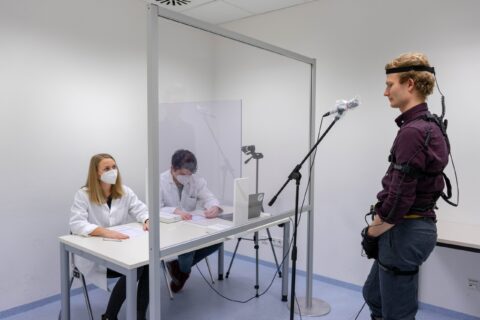Identifying acute stress based on posture
Does stress in social situations cause a particular posture? Do I move in a different way when I feel under pressure or fear a potential conflict? Researchers at Friedrich-Alexander-Universität Erlangen-Nürnberg (FAU) have been investigating these questions in their research. Using the results of their research, they were able to train machine learning models to distinguish between people who were stressed and those who were not, thus taking the first step towards non-invasive methods of measuring stress.
”We did not know what to expect before the study started.” According to Robert Richer, doctoral candidate at the Machine Learning and Data Analytics Lab, the study, of which he is lead author, is the “first systematic investigation of body movement and posture to focus on stress.” “We posed various hypotheses about how psychological stress could affect the posture of a person. Would some people perhaps overreact and move more vigorously than they would otherwise? Would they wring their hands or do something similar? Or would they just freeze?”
Stress: Looking at the entire body for the first time
In the field of psychology, it is well known that psychosocial stress, which is the stress that occurs during interactions with other people, is the most prevalent type of stress. However, up to now, only samples of blood or saliva have been used to analyze it. A comprehensive analysis of the human body including posture and movement has not been the subject of investigation to date. This could change with the publication of this study conducted by Robert Richter with other researchers at FAU in the DFG-funded collaborative research center “EmpkinS”, the Chair of Health Psychology and the Machine Learning and Data Analytics Lab.
Trier social stress test (TSST) ensures good comparability of results
Firstly, the research team conducted the Trier social stress test (TSST) with the participants of the study. This test has been used since the early 1990s to investigate psychosocial stress and physiological stress reactions. As the test always follows a strict protocol, it is well suited for comparing results. Participants in an TSST are required to participate in an interview and answer mental arithmetic questions. During these 15 minutes, the members of the interview panel remain neutral and do not provide any feedback.
In order to ensure that a direct comparison could be made, the FAU researchers arranged a control situation, namely another interview with similar tasks, but this time the members of the interview panel were friendly and supportive.
Stress reduces our movements
In both interview situation, the participants were fitted with sensors on their whole body: small motion sensors were attached to the head, shoulders, limbs, hands, feet and chest to record all movements. All participants showed a reduction in movement during stressful situations, as well as longer periods of no movement at all. The extent to which movement was reduced or stopped altogether varied according to the individuals, according to Richer. “Individuals who tend to be more active in general move less than usual during stressful situations, but may still demonstrate more movement than another person who moves less in general. However, we detected a reduction in movement to some extent in all participants.”
Support from machine learning
The data gained during the study was used to develop machine learning models, also known as machine learning pipelines, in order to detect acute psychosocial stress based on movement alone. The artificial learning models accurately recognized whether individuals were stressed or not in just under 75% of cases. The researchers are very pleased with the results. On the basis of these figures, it seems realistic that machine learning can be used in future in order to assess acute stress on the basis of posture and movement.
Collaborative research center “EmpkinS”
Collaborative research center SFB 1483 “EmpkinS” (Empatho-Kinaesthetic Sensory Systems) combines touch-free radar, wireless and camera-based sensor technologies with innovative signal processing methods and artificial intelligence in order to modernize options for medical and psychological diagnosis and treatment. Further information on current studies and research projects: https://www.empkins.de/
Learning machines and ethics
Using artificial intelligence can simplify procedures and lead to greater efficiency in the various areas where it is used. However, AI is also a source of anxiety and worry. For this reason, the EmpkinS projects are accompanied by ethics experts at FAU. They analyze the projects from a moral point of view, ensuring that all research is indeed ethical.
Future applications: Contactless stress analysis
Stress tests based on biomarkers such as blood and saliva are expensive and complicated. For example, blood tests must be taken on an empty stomach, and only a certain amount of fluid can be taken on one day. Generally speaking, wet samples such as these are subject to specific rules concerning taking, storing and transferring the samples to the laboratory. This is the reason why, in the long term, Prof. Dr. Nicolas Rohleder, holder of the Chair of Health Psychology and lead investigator in the study hopes that these methods will become obsolete in future. “We can see that stress is becoming a burden across society, reflected in costs for health care and in increased absences at work. Based on this study, we hope to develop a contactless method for investigating and ultimately leading to a better understanding of stress. Instead of having to use a needle, observations by learning machines may be all that is needed in future.”
*To the study: Machine learning-based detection of acute psychosocial stress from body posture and movements | Scientific Reports (nature.com)
